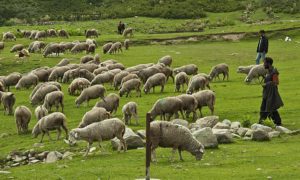Rampant construction shrinks Pampore’s saffron fields
Srinagar: The unabated constructions have taken a heavy toll on the saffron production in south Kashmir’s Pampore area with a considerable cultivation land has turned into residential area over the years.
As per the official figures of the Agriculture Department, the saffron land has been shrinking at Pampore. This is because the government has failed to stop unabated constructions on the land despite Saffron Act 2007, which was to preserve it.
As per the official figures, saffron crop was being cultivated on 5707 hectares of land at Pampore in 1996, which has now reached to around 3500 hectares, indicating that 2200 hectares of saffron land has come under constructions over the years.
“The land has shrunk because of constructions. Government needs to take some strict measures from turning saffron land into residential area,” an official of the Agriculture Department told KNS.
To give boost to the saffron production, ministry of Agriculture and Production, Government of India started a scheme ‘National Mission on Saffron’ in 2010 for seven years with project cost of Rs 400.11 crore. So far, the government has utilised only Rs 199.835 crore. The centre has extended the period of completion by March 2018. However, the state has recommended its extension to March 2019.
President, Saffron Growers Association, Abdul Majeed Wani, said farmers started using new technology under the centrally sponsored scheme. “But the irrigation project has not been completed,” he said.
He said that decline in saffron production was due to dry weather.
Ghulam Mohidin, a saffron grower said, he would cultivate saffron over five hectares of land at Pampore, two decades back. However, these days he is worried that there may be decline in saffron production due to dry weather. The government has so far failed to keep the irrigation facilities available.
“Had there been irrigation facilities available, we would not have been dependent on rainfall,” he said.
Saffron flowers are sensitive to vagaries of the weather. Its production depends on the weather conditions and the irrigation facilities. There has been slight rainfall for the last three months in the valley.
He held several reasons responsible for decline in its production. “The government did not show much concern for the prized crop. The authorities are not implementing schemes properly,” he said.
“People also sold a large part of saffron land on which constructions have been built,” he added.
Farooq Ahmad, another saffron grower, said that saffron production has been on decline due to government’s “mismanagement”. “The funds of centrally sponsored scheme have been kept unspent. There is water deficit and the government has failed to complete the irrigation project,” Farooq said.
A senior official of the Agriculture Department said that saffron growers were “not coming forward” to get benefits under the scheme. “The saffron production has been increased. However, the irrigation component of the scheme has not been completed yet. Saffron growers are also not coming forward to get benefit under the scheme,” the official said.
He admitted that constructions were raised on the saffron land over the years. He said land mafia was creating hurdles for laying of pipe network for irrigation facilities. He said that Iranian saffron, which does not match the quality of Kashmir saffron, was being imported in India. “It is being rebranded and sold in domestic market on high value thereby defacement of the Kashmir saffron,” he added.
(With inputs from KNS)








